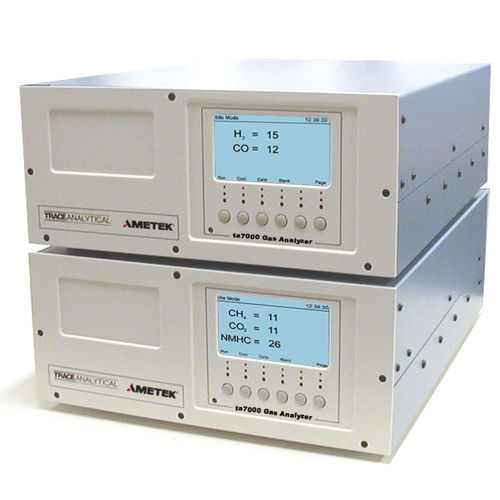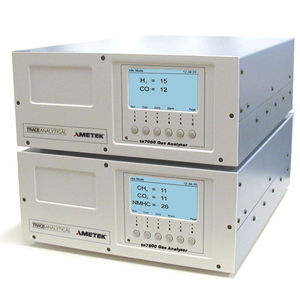
- Metrology - Laboratory
- Analytical Instrumentation
- Gas analyzer
- AMETEK Process Instruments
Gas analyzer ta3000 monitoringlaboratorytrace
Add to favorites
Compare this product
Characteristics
- Measured entity
- gas
- Application domain
- monitoring, laboratory
- Measured value
- trace
- Configuration
- benchtop
- Technology
- flame ionization
Description
Available in two models, the ta3000 gas analyzer is an isothermal gas chromatograph that can be configured with a reduction gas detector or flame ionization detector.
The analyzer offers extreme measurement sensitivity from parts-per-million (ppm) down to low parts-per-billion (ppb) levels, and negligible matrix effects from permanent gases. Combined with the separating power of gas chromatography, it provides a unique system.
The ta3000R uses a single high-sensitivity reduction gas detector to measure hydrogen, carbon monoxide and unsaturated hydrocarbons. The ta3000F has a highly sensitive flame ionization detector which monitors carbon dioxide, methane and non-methane hydrocarbons.
Configurable for a wide range of trace gas monitoring applications, the ta3000 series offers solutions for markets in the hydrocarbon processing, industrial gas, LCD/OLED display manufacturing and semiconductor industries.
HIGHLY CONFIGURABLE
In addition to a choice between reduction gas and flame ionization detectors, the chromatographic hardware of the ta3000 is available in several configurations, enabling the instrument to perform highly specialized tasks.
EFFECTIVE MONITORING
Designed for continuous operation, the ta3000 fits a traditional 19-inch industrial rack installation, and is sturdy enough for transport to the field for surveys and spot tests. It has a dedicated sample processing system and on-board data analysis electronics.
EXPANDABLE ANALYSIS
When interfaced with the Sigma4000 multipoint stream selector, the ta3000 can monitor several sampling points.
Catalogs
ta3000 Gas Analyzers
2 Pages
MGB1000 Micro Gas Blender
2 Pages
Other AMETEK Process Instruments products
Trace analytical
Related Searches
- Gas analyser
- Concentration analyser
- Monitoring analyser
- Liquids analyser
- Automated analyzer
- Desktop analyzer
- Dust analyzer
- Process analyser
- Portable analyser
- Continuous analyser
- Integration analyser
- Water analyser
- Oxygen analyser
- Real-time analyser
- Compact analyser
- Laboratory analyser
- Digital analyser
- NDIR analyzer
- Spectrophotometer
- Calibration analyser
*Prices are pre-tax. They exclude delivery charges and customs duties and do not include additional charges for installation or activation options. Prices are indicative only and may vary by country, with changes to the cost of raw materials and exchange rates.







